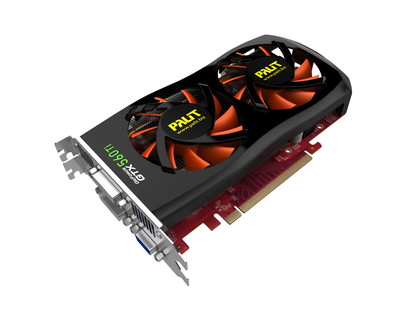Why you can trust TechRadar

One of the things that Palit brings to the overclocking market is the ability to not only drop superior cooling onto their cards, thanks to the scale of its operation it can redesign the reference PCB and produce its own versions of the cards rather than relying on rebadged, bin-sorted reference cards.
The first thing you'll notice about the Palit GeForce GTX 560 Ti Sonic is the fact that it is so very teeny-tiny.
Compared to the increased scale of Zotac's GeForce GTX 560 Ti AMP! card's redesigned PCB it looks for all the world like a low-end card with an unnecessary cooler strapped to it.
It's still a dual-slot card, but is significantly shorter than even the reference design. Still though Palit has managed to fit a dual-fan cooler onto it to give that stressed GPU some much-needed chilling.
It does come with a pretty healthy overclock on it too. Compared to the 822MHz core clock of the reference design you're looking at 900MHz straight out of the box.
That's not as crazy as the 128MHz boost you get on the Zotac GeForce GTX 560 Ti AMP! but it's still a pretty hefty performance hike.
That's born out by the increased performance in the benchmark tests.
You're looking at around a 10% increase on average across the suite, and considering the GTX 560 Ti Sonic is less than a tenner more expensive than the £199 MSRP of the reference designed cards that's pretty good.
We were hoping that the redesigned PCB and improved cooling solution might enable us to reach the sort of speeds the Zotac AMP! edition is capable of out of the box, unfortunately though the GTX 560 Ti Sonic while operates at 950MHz it is a trifle flaky.
That's a shame for Palit, but it does mean the Zotac card still rules the roost as the best example of the GTX 560 Ti, and almost justifies the price premium it is charging for the privilege.
The Radeon HD 6950 is still a fly in the GTX 560 Ti's overclocked ointment, and it's all down to the BIOS flash that gives the reference Radeon's a transformation into fully fledged HD 6970s.
I've got a feeling AMD might be starting to phase out the dual-BIOS on the Cayman cards to call a halt to the BIOS flashing, but for the moment it's still very much a possibility.
And one hell of a selling point.
We liked
The size of the Palit GeForce GTX 560 Ti Sonic is also a selling point. For those with a paucity of space in their chassis this reduced footprint could be a godsend, and should make a good base for a portable LAN rig too.
It's also a very competitive price for an overclocked version. If you can't afford to stretch for the HD 6950 this Sonic edition is a good bet.
We disliked
It was a bit of a disappointment that we couldn't push it to what seems to be the GTX 560 Ti's maximum of 950MHz, but realistically that's not a huge issue considering the relative price.
Final word
For just a little more than the price of the vanilla GTX 560 Ti the Palit Sonic edition represents good value and excellent performance. That said for another tenner you can pick up a Radeon HD 6950 that's ripe for a good ol' flashing.
Current page: Palit GeForce GTX 560 Ti Sonic: Verdict
Prev Page Palit GeForce GTX 560 Ti Sonic: Benchmarks